
What Is Zero Force Member?

Zero force members are members in a truss/frame that theoretically have no force in them. Being able to identify these members swiftly will aid you on the PE Exam and in life in general (possibly).
Zero-force members are the members in the truss with no force acting on it. There are generally three types of force acting on the member of the truss. They are compressive, tensile, and axial force.
If there is no force in the member, it does not mean that it should be avoided during construction. Zero Force members also have many functions, which I will discuss with you at the end of the article.
In a truss system, some members are not carrying any force. This called a zero-force member. This member may be added to increase truss stability. Identifying these members will simplify the process of analyzing truss.
What Is Zero Force Member for Truss?

Truss analysis using the method of joints is greatly simplified if one is able to first determine those members that support no loading.
These zero force members may be necessary for the stability of the truss during construction and to provide support if the applied loading is changed. The zero-force members of a truss can generally be determined by inspection of the joints, and they occur in two cases.
Case – 1.

Consider the truss in above Fig -1 (Truss). The two members at joint “C” are connected together at a right angle and there is no external load on the joint.
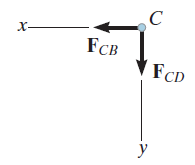
The free-body diagram of joint “C”, Fig – 2 (Truss Joint), indicates that the force in each member must be zero in order to maintain equilibrium.
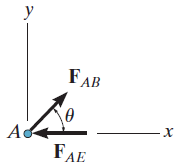
Furthermore, as in the case of joint “A”, Fig – 3 (Truss Joint) this must be true regardless of the angle say θ. between the members.
Case – 2.
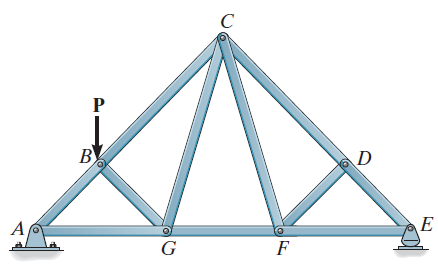
Zero-force members also occur at joints having a geometry as joint “D” in above fig -4 (Truss).
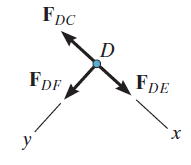
Here no external load acts on the joint, so that a force summation in the y-direction, Fig – 5 (Truss Joint), which is perpendicular to the two collinear members, requires that FDF = 0.
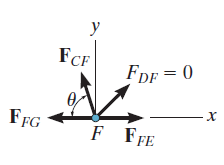
Using this result. “FC” is also a zero-force member, as indicated by the force analysis of joint “F”, Fig – 6 (Truss Joint).
Summary of Zero Force Member for Truss,

Then, if only two non-collinear members form a truss joint and no external load or support reaction is applied to the joint, the members must be zero-force members, Case 1.
Also, if three members form a truss joint for which two of the members are collinear, the third member is a zero-force member, provided no external force or support reaction is applied to the joint, Case 2.
Particular attention should be directed to these conditions of joint geometry and loading. since the analysis of a truss can be considerably simplified by first spotting the zero-force members.
How to Identification of Zero Force Members in Truss?

Because trusses are usually designed to support several different loading conditions, it is not uncommon to find members with zero forces in them when a truss is being analyzed for a particular loading condition.
Zero-force members are also added to trusses to brace compression members against buckling and slender tension members against vibrating.
The analysis of trusses can be expedited if we can identify the zero-force members by inspection.
Two common types of member arrangements that result in zero-force members are the following:
Step – 1. Noncollinear Members

If only two noncollinear members are connected to a joint that has no external loads or reactions applied to it, then the force in both members is zero.
Step – 2. Collinear Member

If three members, two of which are collinear, are connected to a joint that has no external loads or reactions applied to it, then the force in the member that is not collinear is zero.
FAQs on Zero Force Members in Truss Systems
What is a zero-force member in a truss system?
A zero-force member is a member in a truss that theoretically has no force acting on it. These members can be identified through inspection and are essential for the stability and support of the truss under various loading conditions.
Why are zero-force members important in truss design?
Zero-force members are important because they increase the stability of the truss during construction and provide support if the applied loading changes. They also help brace compression members against buckling and slender tension members against vibrating.
How can you identify zero-force members in a truss?
Zero-force members can be identified by inspecting the joints in the truss:
- If only two non-collinear members form a truss joint with no external load or support reaction applied, both members are zero-force members.
- If three members form a truss joint where two of the members are collinear and no external force or support reaction is applied, the third member is a zero-force member.
What are the common conditions that lead to zero-force members?
The common conditions are:
- A joint with two non-collinear members and no external load or reaction.
- A joint with three members where two are collinear and no external load or reaction.
Are zero-force members always zero force under all loading conditions?
No, zero-force members may not always be zero-force members under all loading conditions. They are identified as zero-force members based on a specific loading condition, but different loading scenarios can change the forces in these members.
Should zero-force members be avoided during truss construction?
No, zero-force members should not be avoided. They play a crucial role in the overall stability and performance of the truss, especially under varying load conditions.
How do zero-force members simplify truss analysis?
Identifying zero-force members simplifies truss analysis by reducing the number of members that need to be considered when calculating forces. This can make the analysis quicker and more straightforward.
Can zero-force members change to force-carrying members?
Yes, zero-force members can become force-carrying members if the loading conditions change. This is why they are included in truss designs to ensure the structure can adapt to different loads.

